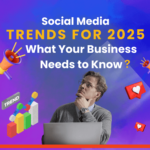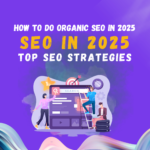
Table of Contents
ToggleHow Businesses Can Use AI in 2025: Future-Ready Strategies for Growth
Artificial Intelligence (AI) continues to reshape industries worldwide, driving automation, improving decision-making, and enhancing customer experiences. As we approach 2025, AI technologies are expected to evolve further, becoming an integral part of business operations. In this blog, we’ll explore how businesses can leverage AI by 2025, key AI-powered strategies, and the transformative impact AI can have on various sectors.
In this guide, we’ll cover everything you need to know about local SEO for small businesses, from the basics to advanced strategies that will help you dominate the local search results. Let’s get started!
Introduction: AI’s Growing Role in Business
AI has already become a game-changer for businesses. In 2025, AI will no longer be a futuristic concept but a necessity for companies aiming to remain competitive. Businesses will need to integrate AI into their core operations to improve efficiency, automate repetitive tasks, and enhance customer experiences.
According to Gartner, companies using AI-driven systems in their operations are expected to increase profitability by 40% by 2025. Let’s explore how businesses can adapt and thrive in this AI-driven future.
For instance, when someone searches for “best coffee shop near me” or “plumber in [city name],” businesses with strong local SEO strategies are more likely to appear at the top of the results, especially in the “Local Pack” (the top three results shown with a map).
Emerging AI Trends to Watch in 2025
Businesses must stay ahead by understanding key AI trends likely to dominate by 2025:
- AI-Powered Automation: Automating repetitive tasks, customer service, and supply chain processes.
- Hyper-Personalization: Delivering personalized experiences using AI-powered customer insights.
- Edge AI: Running AI algorithms on local devices, reducing dependency on cloud computing.
- Autonomous Systems: Self-operating systems such as autonomous delivery drones and vehicles.
- Generative AI Models: Creating custom content, designs, and media using AI tools like ChatGPT.

How Businesses Can Use AI in 2025
Let’s dive deeper into AI-driven strategies that businesses can use in 2025 to stay competitive and innovative:
AI-Powered Customer Service
AI chatbots and virtual assistants are already transforming customer service, and by 2025, they will be more advanced, offering near-human-like interactions. Businesses can implement AI-powered customer service to:
- Offer 24/7 real-time customer support
- Handle high volumes of customer queries
- Deliver personalized service through data-driven insights
- Provide instant solutions, reducing wait times
- Integrate with CRM systems for enhanced customer management
Example: Retail companies can implement AI-powered virtual shopping assistants to help customers choose products and receive personalized recommendations.
AI in Marketing and Sales
AI-driven marketing will become more precise, allowing businesses to target the right customers with the right messages at the right time. AI can help optimize:
- Personalized Marketing Campaigns: Generate personalized product recommendations using AI-powered algorithms.
- Customer Segmentation: Use AI for predictive analytics to understand customer behavior.
- Content Creation: Generate AI-based product descriptions, social media posts, and ad copy.
- Sales Forecasting: Use historical sales data and AI models to predict future revenue.
- Ad Campaign Optimization: Use AI tools like Google Ads AI to optimize ad spending and ROI.
Example: E-commerce brands can use AI-powered recommendation engines, leading to 30% higher sales through personalized suggestions.
AI for Business Automation
AI-powered process automation will dominate in 2025, enabling businesses to streamline various back-end processes such as:
- Inventory Management: Use AI-powered systems to predict demand, optimize stock levels, and reduce waste.
- Supply Chain Optimization: Implement AI-driven logistics and supply chain monitoring for real-time tracking.
- Document Automation: Automate invoice generation, payroll processing, and other repetitive administrative tasks.
- HR Automation: Use AI-driven recruitment tools to screen resumes and find the best talent.
Example: Manufacturing businesses can use AI-driven robotics for automated assembly lines, reducing production costs by 40%.

AI-Powered Data Analytics & Forecasting
By 2025, AI-powered data analytics tools will become indispensable for businesses looking to turn raw data into actionable insights. Key applications include:
- Predictive Analytics: Forecast future market trends based on historical data.
- Business Intelligence Dashboards: AI-powered dashboards offering real-time business insights.
- Customer Insights: Understand customer behavior and preferences through AI-driven analysis.
- Fraud Detection: Identify unusual patterns to prevent financial fraud.
- Sales Projections: Use predictive algorithms for accurate sales forecasting.
Example: Financial institutions can reduce loan defaults by up to 35% using AI-powered credit risk models.
AI in Cybersecurity
In 2025, AI-driven cybersecurity will play a crucial role in protecting businesses from ever-evolving cyber threats. AI-based tools can:
- Detect and respond to cyber threats in real-time
- Identify potential security vulnerabilities before attacks occur
- Perform automated threat intelligence analysis
- Monitor suspicious activities across networks
- Enable multi-factor authentication with biometric data
Example: Businesses can use AI-powered security systems to prevent up to 90% of potential cyberattacks before they occur.
AI in Product Development and Innovation
AI will continue to power product development by automating design, testing, and prototyping processes. Businesses can accelerate innovation through:
- Product Design Automation: Use AI-powered design tools for faster product development.
- Prototyping & Testing: Perform simulations and test products using AI-driven models.
- AI-Generated Content: Use AI for creative content creation such as video production, graphic design, and game development.
- Research & Development: Use AI to analyze scientific data, enabling faster R&D breakthroughs.
- Customization & Personalization: Create custom products using AI-driven production models.
Example: Automotive companies can use AI-driven 3D prototyping to reduce development time by up to 50%.
Challenges Businesses May Face with AI
Despite its potential, businesses adopting AI by 2025 may face some challenges, including:
- Data Privacy Concerns: Ensuring compliance with evolving data privacy laws.
- Integration Complexities: Merging AI tools with existing legacy systems.
- Skill Gaps: A shortage of AI specialists and developers.
- High Implementation Costs: Initial costs for AI adoption may be significant.
- Ethical Concerns: Addressing ethical issues around AI usage.
Preparing for an AI-Powered Future
Businesses must act now to prepare for an AI-driven future by:
- Investing in AI Talent: Hire AI experts or upskill your existing team.
- Partnering with AI Solution Providers: Collaborate with industry experts for tailored AI solutions.
- Creating a Data-Driven Culture: Use data-driven decision-making across departments.
- Ensuring Ethical AI Use: Develop ethical policies for responsible AI use.
Conclusion
AI will be a game-changer for businesses in 2025. From marketing and customer service to cybersecurity and product development, AI-powered technologies will reshape industries and drive innovation. Businesses that invest in AI today will gain a competitive edge, boosting efficiency, reducing costs, and unlocking new growth opportunities.










